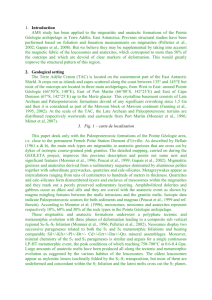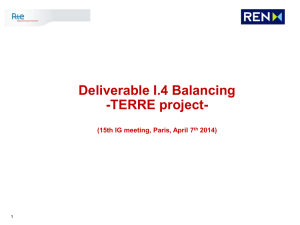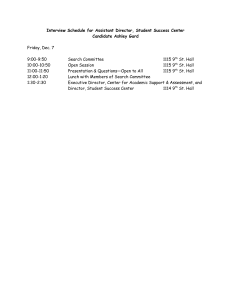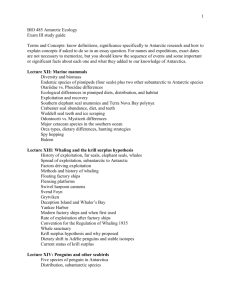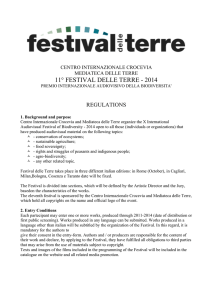Geological setting
advertisement
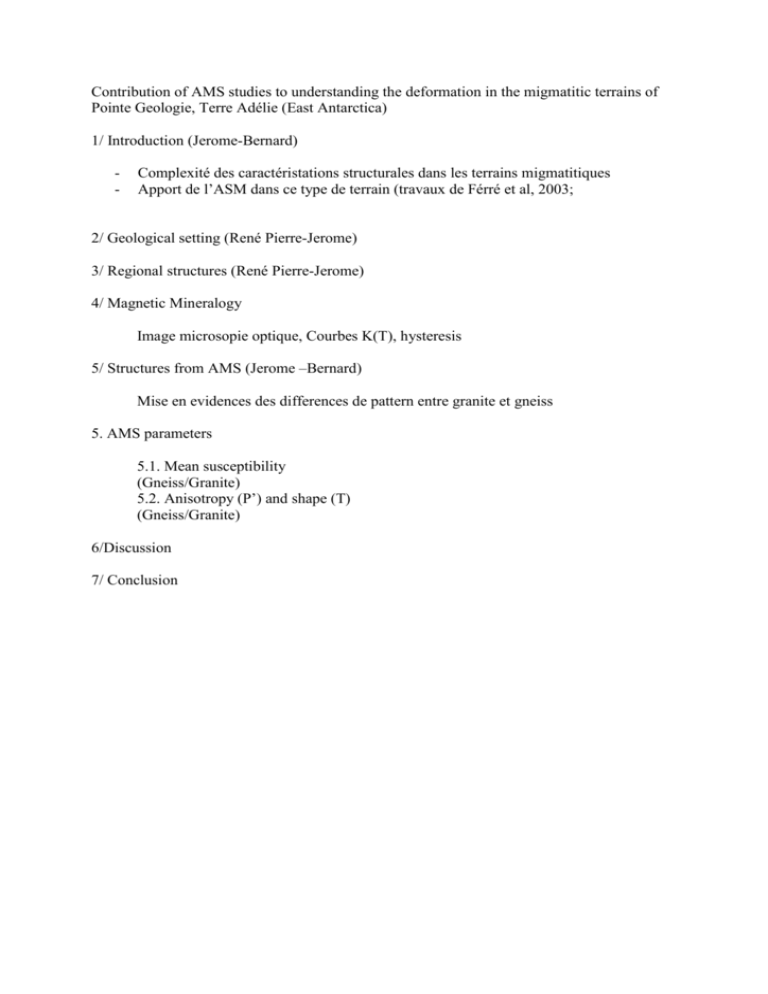
Contribution of AMS studies to understanding the deformation in the migmatitic terrains of Pointe Geologie, Terre Adélie (East Antarctica) 1/ Introduction (Jerome-Bernard) - Complexité des caractéristations structurales dans les terrains migmatitiques Apport de l’ASM dans ce type de terrain (travaux de Férré et al, 2003; 2/ Geological setting (René Pierre-Jerome) 3/ Regional structures (René Pierre-Jerome) 4/ Magnetic Mineralogy Image microsopie optique, Courbes K(T), hysteresis 5/ Structures from AMS (Jerome –Bernard) Mise en evidences des differences de pattern entre granite et gneiss 5. AMS parameters 5.1. Mean susceptibility (Gneiss/Granite) 5.2. Anisotropy (P’) and shape (T) (Gneiss/Granite) 6/Discussion 7/ Conclusion Introduction ……….. AMS study has been applied to the migmatitic and anatectic formations of the Pointe Géologie archipelago in Terre Adélie, East Antarctica. Previous structural studies have been performed based on foliation and lineation measurements on migmatites (Pelletier et al., 2002; Gapais et al., 2008). But we believe they may be supplemented by taking into account the magnetic fabric of the leucosomes and anatexites, which correspond to more than 50% of the outcrops and which are devoid of clear markers of deformation. This would greatly improve the structural pattern of this region. Geological setting The Terre Adélie Craton (TAC) is located on the easternmost part of the East Antarctic Shield. It crops out as islands and capes scattered along the coast between 135° and 145°E but most of the outcrops are located in three main archipelagos, from West to East: around Pointe Géologie (66°50’S, 140°E), East of Port Martin (66°80’S, 142°25’E) and East of Cape Denison (67°S, 142°25’E) up to the Mertz glacier. This crystalline basement consists of Late Archean and Paleoproterozoic formations devoid of any significant reworking since 1,5 Ga and then it is considered as part of the Mawson block or Mawson continent (Fanning et al., 1995, 2002). At the scale of the TAC, the Late Archean and Paleoproterozoic terrains are distributed respectively westwards and eastwards from Port Martin (Monnier et al., 1996; Ménot et al, 2007). - Fig. 1 - This paper deals only with the Paleoproterozoic formations of the Pointe Géologie area, i.e. close to the permanent French Polar Station Dumont d’Urville. As described by Bellair (1961 a & b), the main rock types are migmatitic to anatectic gneisses that are cross cut by dykes of isotropic coarsegrained pink granites. The detailed mapping, carried on during the GEOLETA project, improves this previous description and points out some new and significant features (Monnier et al., 1996; Peucat et al., 1999; Gapais et al., 2002). Migmatitic gneisses and anatexites derived from a sedimentary sequence dominated by aluminous pelites together with subordinate greywackes, quartzites and calc-silicates. Metagreywakes appear as intercalations ranging from tens of centimeters to hundreds of meters in thickness. Quartzites and calcsilicates form dismembered layers of mesosomes within the migmatites and they mark out a poorly preserved sedimentary layering. Amphibolitized dolerites and gabbros occur as dikes and sills and they are coeval with the anatectic event as shown by magma mingling features between the mafic intrusions and the granitic melts. Isotopic data indicate Paleoproterozoic sources for both sediments and magmas (Peucat et al., 1999 and ref. therein). According to Monnier et al. (1996), mesosomes, neosomes and anatexites represent respectively 10%, 60% and 30% of the rock types in the Pointe Géologie archipelago. These mesocrustal formations underwent a polyphased tectonic and metamorphic evolution with three phases of deformation leading to a composite subvertical regional S0-S1-S2 foliation (Monnier et al., 1996; Pelletier et al., 2002). Neosomes display two successive parageneses related to both the S 1 and S2 metamorphic foliations and bearing comparable Sil+/-Kfs+/-Pl+/-Bt+/- Cd+/Grt+/-Ilm+/-Qtz mineral assemblages. Moreover, mineral chemistry of the S1 and S2 parageneses is similar and argues for a single continuous LP-HT metamorphic event, the peak conditions of which reaching 750-700°C at 0.6-0.4 Gpa. A weak retrograde imprint with Bt+/-Ms+/-And assemblages marks the later evolution to about 550-450°C and 0.5-0.4 Gpa (Monnier et al., 1996; Pelletier et al., 2002, 2008). Evolution tectono-metamorphique fusion partielle continue pendant deformation polyphasée single continuous metamorphic event under constant P-T conditions P= T= ; puis retrogression Geochronology (Bellair et Delbos, 1962; Peucat et al., 1999) Regional structures References 1- BELLAIR (1961) - Sur les formations anciennes de l'archipel de Pointe Géologie (Terre Adélie). Comptes rendus de l'Académie des Sciences, Paris, 252: 3087-3089. 2- BELLAIR 1961 - Pétrographie du socle cristallin de la Terre Adélie. Comptes rendus de l'Académie des Sciences, ,Paris, 252: 3296-3298. 3- BELLAIR & DELBOS, 1962 - Age absolu de la dernière granitisation en Terre Adélie. Comptes Rendus de l'Académie des Sciences, Paris, 254: 1465-1466. 4- FANNING C.M., DALY S.J., BENNETT V.C., MÉNOT R.P., PEUCAT J.J., OLIVER R.L. (1995) - The “ Mawson Block ” : once contiguous Archean to Proterozoic crust in the East Antarctic Shield and Gawler Craton, Australia. VII International Symposium on Antartic Earth Sciences, 10-15/09/1995, Sienna, Italy. 5- FANNING C.M.F., MOORE D.H., BENETT V.C., DALY S.J., MÉNOT R.P., PEUCAT J.J., OLIVER R.L., (1999) – The “ Mawson continent ” : The East Antarctic Shield and Gawler Craton, South Australia. 8th International Symposium on Antarctic Earth Sciences, Wellington, NZ, July 1999. Abstract vol. 103. 6- FANNING C.M., MÉNOT R.P., PEUCAT J.J., PELLETIER A., (2002) – A closer examination of the direct links between Southern Australia and Terre Adélie and George V Land, Antarctica. 16th Australian Geological Congress, AGC, Special session in memory of Robin Oliver “ Geology of East Antarctica and its links with Australia and the other southern, continents”, Adelaïde, 30 June – 5 July 2001, Geoscience 2002: Expanding horizons, Abstracts vol. n°67, p.224. 7- GAPAIS D., PELLETIER A., MÉNOT R.P., PEUCAT J.J., (2008) - Paleoproterozoic tectonics in the Terre Adélie Craton (East Antarctica). Precambrian Research, 162, 3-4, 531-539, doi: 10.1016/j.precamres2007 8- Heurtebize, G. (1952) - Sur les formations géologiques de la Terre Adélie. Comptes rendus de l'Académie des Sciences, Paris, 234: 2209-2210. 9- MÉNOT R.P DUCLAUX, G., PEUCAT, J.J., ROLLAND, Y., GUILLOT, S. FANNING, M., BASCOU, J., GAPAIS, D., PECHER, A., (2007) – Geology of the Terre Adélie Craton (135 146°E), in Antarctica: A Keystone in a Changing World—Online Proceedings for the Tenth International Symposium on Antarctic Earth Sciences, edited by Alan Cooper, Carol Raymond et al., USGS Open-file Report 2007-1047, Short Paper 048, 5p.; doi:10.3133/of20071047.spr048. 10- MONNIER O., MÉNOT R.-P., PEUCAT J.J., FANNING M., GIRET A. (1996) - Actualisation des données géologiques sur Terre Adélie (Antarctique Est) : mise en évidence d’un socle protérozoïque hétérogène. . Comptes rendus de l'Académie des Sciences, Paris ,322, IIa, 55-62. 11- PELLETIER A., GUIRAUD M., MÉNOT R.P. (2005) – From partial melting to retrogression in the Pointe Géologie migmatitic complex (East Antarctica): a history of heterogeneous distribution of fluids. Lithos, 81, 153-166. 12- PELLETIER A., GAPAIS D., MÉNOT R.P, PEUCAT J.J., (2002) – Tectonique transpressive en Terre Adélie au Paléoprotérozoïque (Est Antarctique). Comptes rendus Geosciences, 334, 505-511. 13- PEUCAT J.J., MÉNOT R.P., MONNIER O., FANNING M., (1999) – The Terre Adélie basement in the East-Antarctica Shield : geological and isotopic evidence for a major 1.7 Ga thermal event ; comparison with the Gawler Craton in South Australia. Precamb. Res. .94, 205-224
